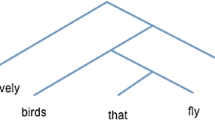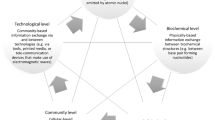Abstract
This paper has two aims. One is to defend an incrementalist view of the evolution of language, not from those who think that syntax could not evolve incrementally, but from those who defend a fundamental distinction between Gricean communication or ostensive inferential communication (Scott-Phillips, Sperber, Tomasello, originally based on Grice) and code-based communication. The paper argues against this dichotomy, and sketches ways in which a code-based system could evolve into Gricean communication. The second is to assess the merits of the Sender–Receiver Framework, originally formulated by David Lewis, and much elaborated and set into an evolutionary context by Brian Skyrms and colleagues, as a framework for thinking about the evolution of language. Despite the great strengths of that framework, and despite the great value of a framework that is both general and formally tractable, I argue that there are critical features of language that it fails to capture .
Similar content being viewed by others
Notes
It may well be that this pragmatics-focused view of language understates the role of syntax, and the ways modifiers and adjectives affect their heads in unobvious ways: a mirror-image of the neglect of pragmatics and semantics by syntax-focused views of language.
A cue is an act (or state) of an agent that can carry information for another agent, but which is not designed or intended to do so. The escape behaviour of one bird is an indication of danger to another, but the bird is not signalling, it is escaping.
Information-sharing is a form of cooperation, and there is analogous puzzle about reciprocal cooperation that suggests that the costs and benefits have not been properly identified. Just as with signalling, models of cooperation also indicate that reciprocal cooperation should evolve quite readily. Models suggest that reciprocal cooperation does not depend on ecologically implausible cost–benefit ratios, or implausible rates of future interaction. Yet there are very few clear examples (see Boyd 2016 for a discussion of this puzzle).
I mention proto-language here to side-step the issue of syntax, and whether it could evolve incrementally.
Moreover, some of the reports are at best very marginal cases of pantomime “Orangutans groomed a partner briefly to solicit grooming; so do chimpanzees and gorillas” (Russon and Andrews 2011a, p. 315).
See in particular their tabulated summary on Hobaiter and Byrne (2014, p. 1598).
Or so they argue. However, Richard Moore points out that they have not excluded the possibility that some of the signals are just attention grabbing, with response specificity depending on context and the audience’s best guess at what the target wants (Moore 2014).
Identifying the desired response is not at all trivial. If the target of the gesture responds in a way that causes the gesturing agent to stop gesturing, and if that agent does not show obvious signs of frustration and anger, then the response is deemed to have been the intended outcome of the gesture.
In Genty and Zuberbuhler (2014) it is claimed that bonobos sometimes solicit sexual partners with a beckoning gesture allied with orienting their body to a specific location, and that this has iconic as well as spatial elements. But at best the iconicity is minimal, and its not clear that uptake depends on the iconic character of the gesture (supposing that it is iconic). There is also some suggestion that auditory iconicity (or sound symbolism) may also have helped bootstrap language (see Imai and Kita 2014).
The same is true of reinforcement or reward, if we think of these changes as happening within the lifespan of individual agents rather than in their lineage.
Ron Planer has pointed out to me that some defenders of the ostensive intentional conception of communication think that children younger than four fail language-based versions of the false belief task because they cannot perform multiple mindreading tasks in the one interaction, rather than because they cannot integrate language use and mindreading. But that predicts that children younger than four are incapable of conversational interaction in groups of three or more, for all such interactions, on their own analysis, involve multiple mindreading requirements.
References
Apperly IA (2011) Mindreaders: the cognitive basis of ‘theory of mind’. Psychology Press, Hove and New York
Apperly IA, Butterfill S (2009) Do humans have two systems to track beliefs and belief-like states? Psychol Rev 116(4):953–970
Berwick RC, Chomsky N (2016) Why only us: language and its evolution. MIT Press, Cambridge
Biernaskie JM, Grafen A, Perry JC (2014) The evolution of index signals to avoid the cost of dishonesty. Proc R Soc B 281(1790). https://doi.org/10.1098/rspb.2014.0876
Bohn M, Call J, Tomasello M (2016) The role of past interactions in great apes’ communication about absent entities. J Comp Psychol 130(4):351–357
Boyd R (2016) A different kind of animal: how culture made humans exceptionally adaptable and cooperative. Princeton University Press, Princeton
Cathleen OG, Kliesch C, Smith K, Scott-Phillips TC (2015) The ease and extent of recursive mindreading, across implicit and explicit tasks. Evol Hum Behav 36(4):313–322
Christiansen MH, Chater N (2016) The Now-or-Never bottleneck: a fundamental constraint on language. Behav Brain Sci 39:e62
Crockford C, Wittig RM, Mundry R, Zuberbuhler K (2012) Wild chimpanzees inform ignorant group members of danger. Curr Biol 22(January 24):142–146
Dawkins R, Krebs J (1978) Animal signals: information or manipulation. In: Krebs JR, Davies NB (eds) Behavioural ecology. Blackwell, Oxford, pp 282–309
Fodor JA (1983) The modularity of mind. MIT Press, Cambridge
Genty E, Zuberbuhler K (2014) Spatial reference in a bonobo gesture. Curr Biol 24(July 21):1601–1605
Genty E, Breuer T, Hobaiter C, Byrne R (2009) Gestural communication of the gorilla (Gorilla gorilla): repertoire, intentionality and possible origins. Anim Cogn 12(3):527–546
Grice HP (1957) Meaning. Philos Rev 66:377–388
Grice HP (1969) Utterer’s meaning and intentions. Philos Rev 78:147–177
Heyes C (2014) False belief in infancy: a fresh look. Dev Sci 17:647–659
Hobaiter C, Byrne R (2014) The meanings of chimpanzee gestures. Curr Biol 24(July 21):1596–1600
Imai M, Kita S (2014) The sound symbolism bootstrapping hypothesis for language acquisition and language evolution. Philos Trans R Soc Ser B 369(1651):20130298
Kahneman D (2011) Thinking, fast and slow. Macmillan, London
Laidre M, Johnstone R (2013) Animal signals. Curr Biol 23(18):R829–R833
Lewis DK (1969) Convention. Harvard University Press, Cambridge
Maynard Smith J, Harper D (2003) Animal signals. Oxford University Press, Oxford
Millikan R (1998) Language conventions made simple. J Philos 94(4):161–180
Moore R (2014) Ape gestures: interpreting chimpanzee and bonobo minds. Curr Biol 24(14):R645–R647
Moore R (2015) Meaning and ostension in great ape gestural communication. Anim Cogn 19(1):223–231
Moore R (2016) Gricean communication and cognitive development. Philos Q 67(267):303–326
Morrison R (1981) A field guide to the tracks and traces of Australian animals. Adelaide, Rigby
Onishi KH, Baillargeon R (2005) Do 15-month-old infants understand false beliefs? Science 308(5719):255–258
Planer R (2017a) Protolanguage might have evolved before ostensive communication. Biol Theory 12:72–84
Planer R (2017b) Talking about tools: Did early pleistocene hominins have a protolanguage? Biol Theory. https//doi.org/10.1007/s13752-017-0279-1
Putnam H (1975) Mind, language and reality: philosophical papers, vol 2. Cambridge University Press, Cambridge
Russon A, Andrews K (2011a) Pantomime in great apes: Evidence and implications. Commun Integr Biol 4(3):315–317
Russon A, Andrews K (2011b) Orangutan pantomime: elaborating the message. Biol Lett 7(4):627–630. https://doi.org/10.1098/rsbl.2010.0564
Scott-Phillips T (2015) Speaking our minds. Palgrave-Macmillan, London
Scott-Phillips T (2017) Pragmatics and the aims of language evolution. Psychon Bull Rev 24:186–189
Searcy W, Nowicki S (2005) The evolution of animal communication: reliability and deception in signaling systems. Princeton University Press, Princeton
Shaw-Williams K (2014) The social trackways theory of the evolution of human cognition. Biol Theory 9(1):16–26
Skyrms B (2010) Signals: evolution, learning, and information. Oxford University Press, New York
Sperber D, Wilson D (1986) Relevance: communication and cognition. Blackwell, Oxford
Tomasello M (2008) Origins of human communication. MIT Press, Cambridge
Tomasello M (2014) A natural history of human thinking. Harvard University Press, Cambridge
Acknowledgements
Thanks to Stephen Mann, Richard Moore, Ron Planer and Matt Spike for their comments on an earlier version of this paper; thanks also to the Australian Research Council for their generous funding of my research on human social and cognitive evolution.
Author information
Authors and Affiliations
Corresponding author
Rights and permissions
About this article
Cite this article
Sterelny, K. From code to speaker meaning. Biol Philos 32, 819–838 (2017). https://doi.org/10.1007/s10539-017-9597-8
Received:
Accepted:
Published:
Issue Date:
DOI: https://doi.org/10.1007/s10539-017-9597-8




